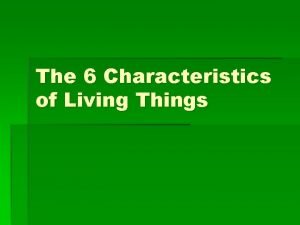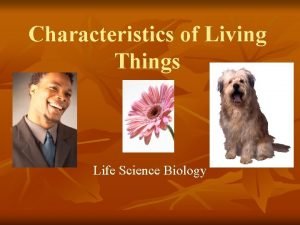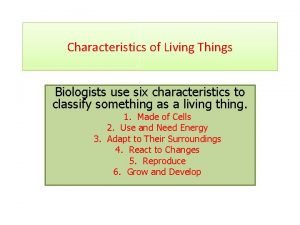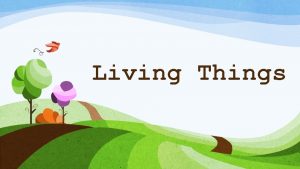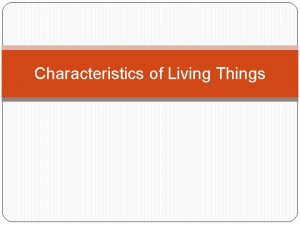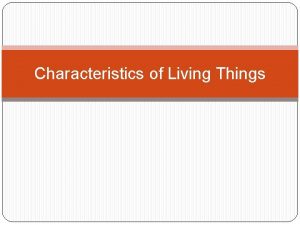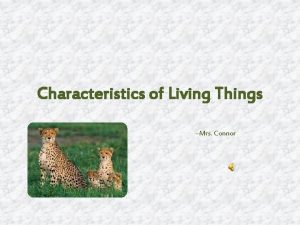CHARACTERISTICS OF LIVING THINGS There are six characteristics







- Slides: 7

CHARACTERISTICS OF LIVING THINGS There are six characteristics that all living things share: 1. Made of Cells 2. Require Energy 3. Grow & Develop 4. Respond to Stimulus 5. Reproduce 6. Composed of certain chemicals

CELLULAR ORGANIZATION • Cells are the basic building blocks of life…of it’s alive…it’s made of cells. • Every living thing is composed of one or more cells. • Organisms (that’s a living thing) can be single-celled or made of many cells. • Viruses aren’t made of cells…guess what…they’re not alive. Too bad for them…they can’t get into the movies or play the drums…as far as I know anyway.

USE ENERGY • Metabolism is the term that refers to all of the activities that go on within a single cell or an entire organism. • Energy is required in order to carry out all of these cellular activities. • Metabolic processes include making food, breaking down food, moving materials in and out of cells, and building cells and their components (parts). It’s a lot of work…teenaged cells are lazy…look for them on the couch watching TV…tragic

GROW AND DEVELOP • All living things grow at some period of their lives. • Unicellular (single-celled) organisms simply grow larger. • Multi-cellular organisms (made of many cells) grow by increasing their number of cells. • Many organisms go through stages of development. Some just a few…others have many.

RESPONSE TO STIMULUS • All living things encountering a change in their environment will respond to that change. • Some responses are drastic and some are more subtle…you can’t even see it happen. • If you hear a loud noise you might jump…BOO! See…calm down now. That’s a response. • A plant might grow toward a light source…that’s a response too, but you can’t see it happening. Go ahead try to frighten a plant…it’ll ignore you and you’ll just look silly. • A stimulus can be: gravity, light, chemicals, vibration, sound, temperature, electricity, etc.

REPRODUCE • All organisms make other organisms like themselves. • Some living things reproduce asexually, others sexually…some…both…no kidding! • Asexual Reproduction – single parent produces offspring (fission, budding). Offspring is genetically identical to the parent. • Sexual Reproduction– two parents required for reproduction (conjugation) and offspring are a combination of genetic material from both.

MADE OF Certain Biological Molecules (CHEMICALS) 1. Carbohydrates – made of sugars, used for energy 2. Proteins-made up of amino acids. Some are structural (for building) and some are enzymes (needed for chemical reactions). 3. Lipids, fats, and oils – long-term energy storage and cell membrane construction 4. Nucleic Acids (DNA & RNA)– provide the cell’s genetic instructions; also needed to make proteins. 5. Starburst (Cherry only)- needed to rot your teeth and make you all hyper from too much

